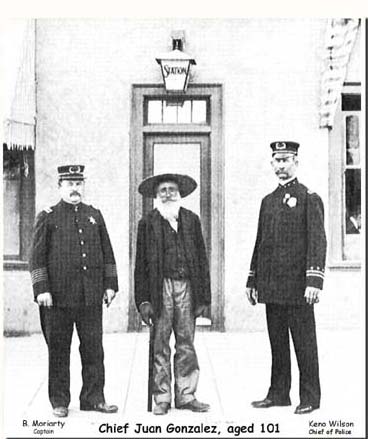David Bejarano San Diego Police Chief
By Roy Cook
Police chief David Bejarano is on the job. It has been almost four years
since he was sworn in by Mayor Susan Golding. He took over the job with
optimism. He has weathered the early storms and remains upbeat. "Some
might call these problems, or challenges," he says. "I see opportunities.
I hope they'll help us reach out to communities we've not been reaching
in the past ... and to be more involved in problem-solving than ever."
Very apropos to his statement is this months presentation at the Indian
Task Force Networking Coalition September 27, 2002. This noon monthly
meeting of Native American organization representatives meets at the City
of San Diego Clairmont Service Center-4731 Clairmont Drive, 1-858-581-4111.
Task Force member SDPD Officer Ralph Cummings, Commanche hosted this pot
luck meeting. This location is very convenient for the secretary/Historian
Roy Cook, Opata/Osage, who is also Humanities Professor of Fine Art at
Mesa College. The Tonkawa Elders organization is represented by Easter
Abrahano, Choctaw and Rose Davis, Seminole who is the Editor and publisher
of INDIAN VOICES newspaper. It is also located in close proximity is the
office of the San Diego Schools Indian Education program led by Vickie
Gambala, Cherokee. She is also President of the IHRC (Indian Human Resource
Center) community board. For a more complete listing of the member organizations
Ms Gambala can be reached at 1-858-627-7363.
The metropolitan San Diego Police Department was established May 16, 1889. On June 1, of that year, Joseph Coyne, the city marshal, was appointed the first Anglo - American chief of police. Of special note to the networking meeting is the traditional presentation of a Pendelton blanket along with a photograph of the first Police 'Chief" Juan Gonzales, Kumeyaay Nation. In the picture is the first New Town station house and Captain Coyne.
 |
Esther Abrahano and Vickie Gambala did the honors. Special assistant
to the chief of Police, David Contreras was delighted to see the evidence
of the photo. It had been a rumor in the station house for some time.
This author shared in the warm reception and satisfaction of being a service
to the community. This alone is worth the hours of research and further
computer graphic work by Ben Nance.
 |
The first police uniform consisted of derby hats, coats with high collars
and badges with seven-point stars.
Chief Coyne was paid $125 a month, his officers $100 a month; they worked
12-hour days, seven days a week. In 1895 shifts were reduced to eight
hours -- but salaries also dropped: $25 a month. Mounted patrolmen furnished
their own horses, but did receive $100 a month for feed and care of their
animals. The modern mounted patrol began in 1934 in Balboa Park. It was
abolished in 1948, but was re-established in 1983 and remains active today.
The first police headquarters was in City Hall at Fifth Avenue and G Street.
Several moves later, the department relocated at Dead Man's Point, named
because of its use as a burial place for sailors and marines during the
charting and surveying of San Diego Bay. The department remained there
-- at 801 West market Street -- until 1987, when it moved into its current
seven-story headquarters building at 1401 Broadway.
Chief David Bejaranos accessibility and involvement in the San Diego is
well documented. Take note of this program. Safe Streets Now! SDPD can
help neighbors get rid of other public nuisances such as gang activities,
prostitution, illegal sales of alcoholic beverages, excessive noise, and
"eye-sore" properties.
Information about this project can be obtained by calling the Safe Streets
Now! Office at (619) 299-5408 or by visiting your local SDPD Storefront
or Satellite Office. Additional information about controlling drugs in
your neighborhood can be obtained by calling the Drug Information and
Strategy Clearinghouse at (800) 578-3472. Chief David Bejarano (619) 531-2777